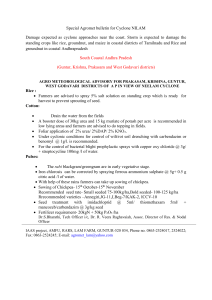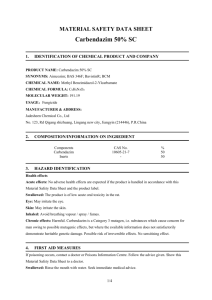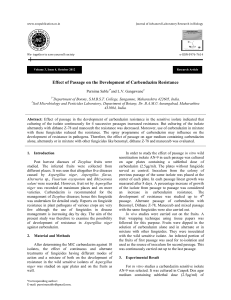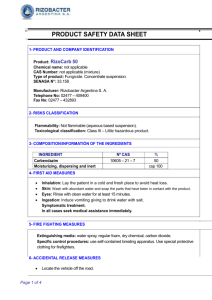Integrated Management of Zizyphus Fruit Rot Caused by Carbendazim Resistance Using other Fungicides Combination with Carbendazim
advertisement
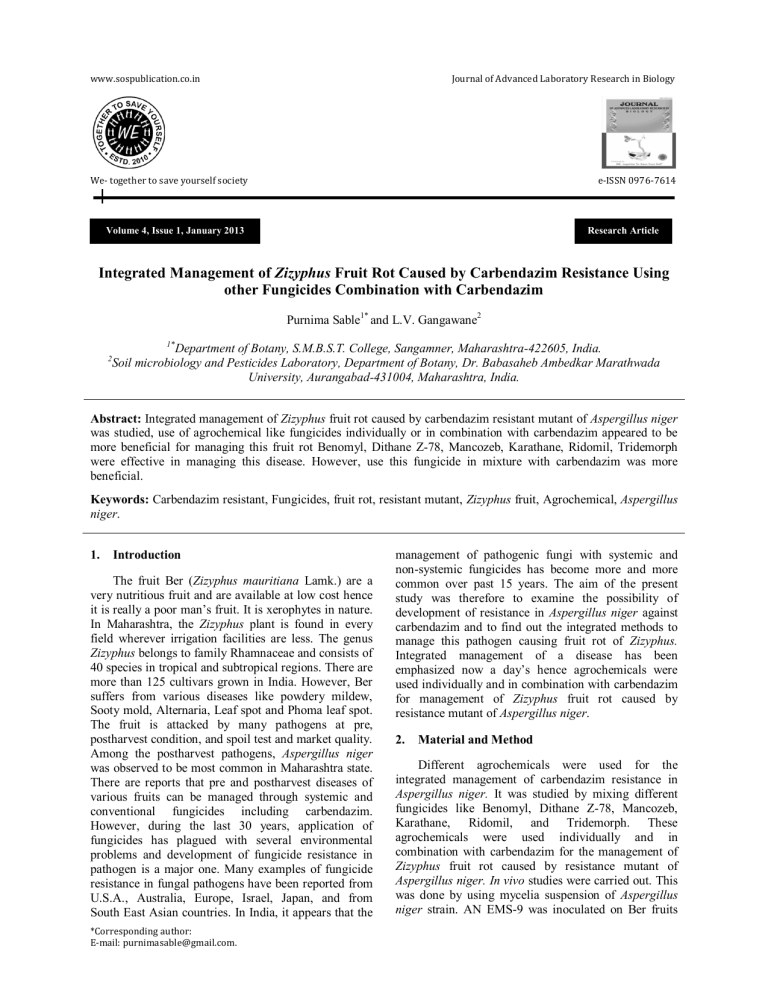
www.sospublication.co.in Journal of Advanced Laboratory Research in Biology We- together to save yourself society e-ISSN 0976-7614 Volume 4, Issue 1, January 2013 Research Article Integrated Management of Zizyphus Fruit Rot Caused by Carbendazim Resistance Using other Fungicides Combination with Carbendazim Purnima Sable1* and L.V. Gangawane2 1* 2 Department of Botany, S.M.B.S.T. College, Sangamner, Maharashtra-422605, India. Soil microbiology and Pesticides Laboratory, Department of Botany, Dr. Babasaheb Ambedkar Marathwada University, Aurangabad-431004, Maharashtra, India. Abstract: Integrated management of Zizyphus fruit rot caused by carbendazim resistant mutant of Aspergillus niger was studied, use of agrochemical like fungicides individually or in combination with carbendazim appeared to be more beneficial for managing this fruit rot Benomyl, Dithane Z-78, Mancozeb, Karathane, Ridomil, Tridemorph were effective in managing this disease. However, use this fungicide in mixture with carbendazim was more beneficial. Keywords: Carbendazim resistant, Fungicides, fruit rot, resistant mutant, Zizyphus fruit, Agrochemical, Aspergillus niger. 1. Introduction The fruit Ber (Zizyphus mauritiana Lamk.) are a very nutritious fruit and are available at low cost hence it is really a poor man’s fruit. It is xerophytes in nature. In Maharashtra, the Zizyphus plant is found in every field wherever irrigation facilities are less. The genus Zizyphus belongs to family Rhamnaceae and consists of 40 species in tropical and subtropical regions. There are more than 125 cultivars grown in India. However, Ber suffers from various diseases like powdery mildew, Sooty mold, Alternaria, Leaf spot and Phoma leaf spot. The fruit is attacked by many pathogens at pre, postharvest condition, and spoil test and market quality. Among the postharvest pathogens, Aspergillus niger was observed to be most common in Maharashtra state. There are reports that pre and postharvest diseases of various fruits can be managed through systemic and conventional fungicides including carbendazim. However, during the last 30 years, application of fungicides has plagued with several environmental problems and development of fungicide resistance in pathogen is a major one. Many examples of fungicide resistance in fungal pathogens have been reported from U.S.A., Australia, Europe, Israel, Japan, and from South East Asian countries. In India, it appears that the *Corresponding author: E-mail: purnimasable@gmail.com. management of pathogenic fungi with systemic and non-systemic fungicides has become more and more common over past 15 years. The aim of the present study was therefore to examine the possibility of development of resistance in Aspergillus niger against carbendazim and to find out the integrated methods to manage this pathogen causing fruit rot of Zizyphus. Integrated management of a disease has been emphasized now a day’s hence agrochemicals were used individually and in combination with carbendazim for management of Zizyphus fruit rot caused by resistance mutant of Aspergillus niger. 2. Material and Method Different agrochemicals were used for the integrated management of carbendazim resistance in Aspergillus niger. It was studied by mixing different fungicides like Benomyl, Dithane Z-78, Mancozeb, Karathane, Ridomil, and Tridemorph. These agrochemicals were used individually and in combination with carbendazim for the management of Zizyphus fruit rot caused by resistance mutant of Aspergillus niger. In vivo studies were carried out. This was done by using mycelia suspension of Aspergillus niger strain. AN EMS-9 was inoculated on Ber fruits Integrated Management of Zizyphus Fruit Rot Caused by Carbendazim Resistance for pathogenicity test. Ber fruit were surface sterilized with 0.01% HgCl2 solution and washed 10 times with sterile distilled water. They were inoculated with a spore suspension of Aspergillus niger isolates or mutant resistant to carbendazim. Percentage Control Efficacy (PCE) was calculated (Cohen, 1989). In order to study, the effect of carbendazim and other agrochemicals, percentage control Efficacy (PCE) was calculated by using the following formula: PCE = 100 (1-X/Y) Where X = Diameter of the colony on the plates containing carbendazim; Y = Diameter of the colony on absolute control plates. Percentage control efficacy (PCA) was recorded after 12 days. In vitro wild sensitive isolate AN-9 was cultured on agar plates containing a sublethal dose of carbendazim (2.5mg/ml). The plate with carbendazim only served as control. And different fungicides like Benomyl, Dithane Z-78, Mancozeb, Karathane, Ridomil, and Tridemorph were mixed in carbendazim by food poisoning technique (Nene and Thapliyal, Sable and Gangawane 1982). The principle involved in this technique is to “poison” the nutrient medium with a fungi toxicant and allowing a test fungus to on such medium (Zapek-Dox) medium (2x) was prepared. It was sterilized and 10ml of this medium was properly mixed with 10ml of carbendazim alone and combination with other agrochemical (2x a.i. concentration) selected for study in sterile Petri plates. These agrochemicals were used individually and in combination with carbendazim. 3. Experimental results Benomyl, Dithane Z-78, Mancozeb, Karathane, Ridomil, and Tridemorph were used in this study. All the fungicides individually showed their PCE more than 52.8. The higher concentration increased PCE up to 70.4. Among these fungicides, Benomyl, Dithane Z-78, Mancozeb and Karathane were more effective than other fungicides. But when the carbendazim was mixed in these fungicides, the PCE was again increased. The higher increase of PCE was seen due to combination of Tridemorph followed by Karathane, Dithane Z-78, Mancozeb and Benomyl in decreasing order (Table 1, and Fig. 1). Table 1. Percentage Control Efficacy (PCA) of Carbendazim individually and in Mixture with other fungicides against resistance strain mutant (AN EMS-9) of Aspergillus niger on fruit of Ber. S. No. 1. 2. 3. 4. 5. 6. 7. Fungicides (mg/ml) Benomyl 50 (mg/ml) Benomyl 100 (mg/ml) Dithane Z-78 50 (mg/ml) Dithane Z-78 100 (mg/ml) Mancozeb 50 (mg/ml) Mancozeb 100 (mg/ml) Karathane 50 (mg/ml) Karathane 100 (mg/ml) Ridomil 50 (mg/ml) Ridomil 100 (mg/ml) Tridemorph 50 (mg/ml) Tridemorph 100 (mg/ml) Carbendazim only (2.5m/ml) Percentage control efficacy Individual In mixture with Carbendazim 58.4 67.2 68.8 70.8 58.0 70.4 71.2 74.0 58.8 62.4 70.4 71.2 59.2 62.8 70.8 75.2 55.2 56.8 58.0 72.8 52.8 68.4 58.8 79.2 54.8 -- Fig. 1. Percentage control efficacy of carbendazim in combination with fungicide against Aspergillus niger to carbendazim on agar plates. J. Adv. Lab. Res. Biol. 24 Integrated Management of Zizyphus Fruit Rot Caused by Carbendazim Resistance 4. Discussion Use of agrochemical individually or in combination with carbendazim appeared in to be more beneficial for managing this fruit rot in the present investigation. Benomyl, Dithane Z-78, Mancozeb, Karathane, Ridomil and Tridemorph gave higher percentage control efficacy individually. But carbendazim in mixture with these agrochemicals enhanced the percentage control efficacy for controlling this disease investigation use of fungicides in combination have been suggested for the management of the level of fungicide resistance in pathogens (Dekker, 1981) with the combination of two specific site inhibitors the possibility exists that the pathogen will acquire resistance to both compounds. This would less likely happen if a combination is used of a systemic fungicide and multisite inhibitor. These results are also confirmative with findings of earlier workers (Dekker, 1981). To prevent, a further case of resistance, CibaGeigy has adopted a basic strategy of the prepacked mixture of metalaxyl with Mancozeb against Oomycetes (Staub and Sozzi, 1981). In addition (Raju and Rao, 1985) have found that combined application of Dithane M-45. With different insecticides can control the fruit rot and pest complex on chilli. (Gangawane and Reddy, 1986) showed that certain micronutrients, when used singly or in mixture with carbendazim, reduce resistance in Aspergillus niger singly or mixture with carbendazim reduces resistance in Aspergillus flavus. There are theoretical models developed on this basis. (Kable and Jeffery, 1980; Skylakakis, 1981; Levy et al., 1983) and practical examples (Delp, 1980; Dekker, 1981; Gangawane and Shaikh, 1988; Gangawane et al., 1990; Gangawane L.V. and B.R.C. Reddy, 1985; Gangawane, L.V. 1981; Dekker, 1981). Suggested that there is a significant delay of resistance build up in the pathogens when mixtures of different fungicides have been used. In the present study, agrochemicals other than fungicides have also been proved useful in the management of carbendazim resistance in Aspergillus niger causing fruit rot of Zizyphus. J. Adv. Lab. Res. Biol. Sable and Gangawane References [1]. Cohen, E. (1989). Evaluation of fenpropimorph and flutriafol for control of sour Rot, blue mold and green mold in lemon fruit. Plant. Dis., 73:807-809. [2]. Dekker, J. (1981). Counter measures for avoiding fungicides resistance. Fungicides resistance in crop protection (Dekker, S.G. Georgopoulos, Eds) C.A.P.D. Wageningen, Netherland, 128-138. [3]. Delp, C.J. (1980). Coping with resistant to plant disease control agent. Plant Disease, 64: 652-657. [4]. Gangawane, L.V. and B.R.C. Reddy (1985). Resistance of Aspergillus flavus to certain fungicides. ISPP Chemical Control Newsletter, 6:23. [5]. Gangawane, L.V. (1981). Fungicides resistance in crop protection. Pesticides, 15:12-16. [6]. Gangawane, L.V. and B.R.C. Reddy (1986). Micronutrient reduces resistance to Carbendazim in Aspergillus flavus. ISPP Chemical Control Newsletter, 7:19-21. [7]. Gangawane, L.V. and S. Shaikh (1988). Development of resistance to aluminium ethyl phosphate in Pythium aphanidermatum. Ind. Phytopath., 41(4):638-641. [8]. Kable, P.F. and H. Jeffery (1980). Selection for tolerance in organisms exposed to sprays of biocide mixtures, theoretical model. Phytopath., 70:8-12. [9]. Levy, Y., R. Levi and Y. Cohen (1983). Buildup of a pathogen subpopulation resistant to a systemic fungicide under various control strategies: a flexible simulation model. Phytopath., 73:1475-1480. [10]. Raju, K.S. and G.S. Rao (1985). Effect of combined application of Dithane M-45 with different insecticides to control of fruit rot and pest complex on chilli. Indian J. Mycol. Plant Pathol.., 15(3):239-246. [11]. Skylakakis, G. (1981). Effects of alternating and mixing pesticides on the buildup of fungal Resistance. Phytopath., 71:1119-1121. [12]. Staub, T. and D. Sozzi (1981). First practical experience with metalaxyl resistance. Neth. J. Plant. Pathol., 87: 233-235. 25
